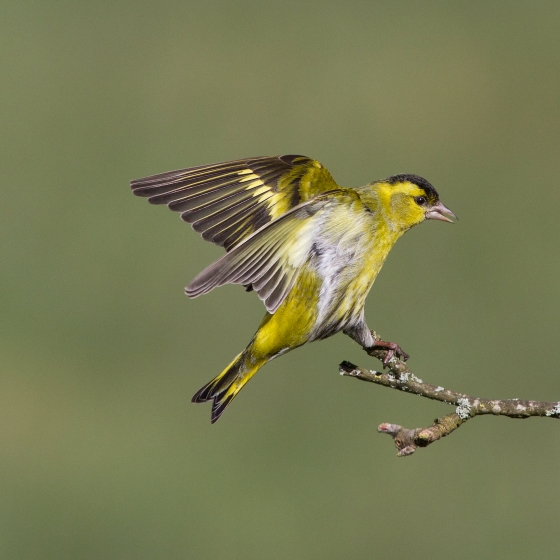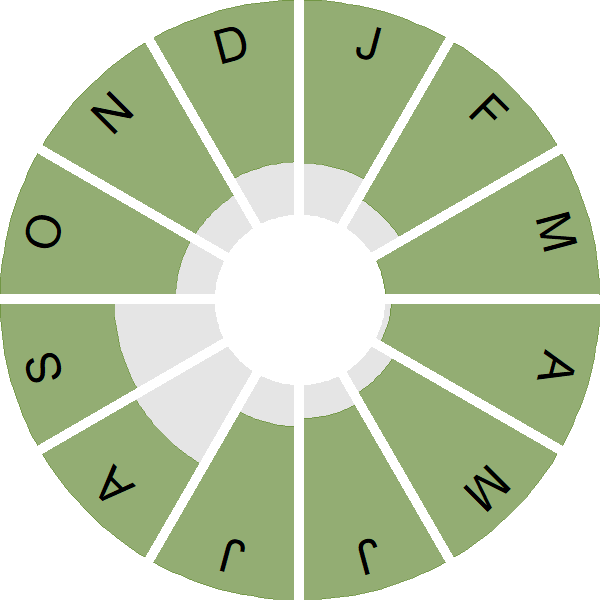Siskin

Introduction
This acrobatic little finch is very much a bird of our pine forests, where its bright yellow rump glows against the dark trees.
Yellow-green with black streaks, the Siskin specialises in feeding on tree seed with those from pine trees particularly favoured, along with Alder and birch. When seeds in the wider countryside begin to run out, Siskins turn to gardens and can be seen feeding alongside some of our more familiar garden birds on our hanging feeders.
The Siskin breeds throughout Britain & Ireland, although it is less commonly found in central and eastern England than in other areas. In winter, Siskins can be found almost anywhere in Britain & Ireland, with breeding populations supplemented by arrivals from elsewhere in Europe.
- Our Trends Explorer gives you the latest insight into how this species' population is changing.

Key Stats
Identification
ID Videos
This section features BTO training videos headlining this species, or featuring it as a potential confusion species.
Green finches in your garden
Songs and Calls
Song:
Call:
Flight call:
Status and Trends
Conservation Status
Population Change
The 1988-91 Breeding Atlas identified a major expansion of the breeding range into southern Britain (Gibbons et al. 1993) and subsequently there have been further considerable range gains, especially in the south and west (Balmer et al. 2013). Progressively more CBC plots became occupied during the 1970s and 1980s (Marchant et al. 1990), but samples were insufficient for annual monitoring until BBS began in 1994. Results since then show parallel fluctuations of extraordinary amplitude in England and Scotland. To some extent, this may reflect the occasional large continental influxes affecting spring numbers on a broad UK scale. There has been a decline across Europe since 1980 (PECBMS: PECBMS 2020a>).
Distribution
Siskins are strongly associated with landscapes dominated by conifer plantations, particularly on moors, low hills and the lower slopes of the uplands. Accordingly breeding Siskins are found through most of Scotland and Wales and much of northern and southwest England, with a patchier distribution elsewhere. In Ireland they are more widespread in the western half of the country, with more-isolated pockets in the east and south.
Occupied 10-km squares in UK
2007/08–10/11
or view it on Bird Atlas Mapstore.
2008–11
or view it on Bird Atlas Mapstore.
European Distribution Map
Distribution Change
Since the 1968–72 Breeding Atlas there has been a 166% range expansion, including gains in Wales, southern and southwestern England and large parts of Ireland. In Scotland, birds have spread into the northeast and onto the Northern Isles and Outer Hebrides. Abundance has also increased since the 1988–91 Breeding Atlas throughout Wales, Scotland and the western half of Ireland.
Change in occupied 10-km squares in the UK
from 1981–84 to 2007–11
or view it on Bird Atlas Mapstore.
from 1968–72 to 2008–11
or view it on Bird Atlas Mapstore.
Seasonality
Siskin is recorded throughout the year.
Weekly pattern of occurrence
The graph shows when the species is present in the UK, with taller bars indicating a higher likelihood of encountering the species in appropriate regions and habitats.

Habitats
Breeding season habitats
Relative frequency by habitat
The graph shows the habitats occupied in the breeding season, with the most utilised habitats shown at the top. Bars of similar size indicate the species is equally likely to be recorded in those habitats.

Movement
Britain & Ireland movement
Foreign locations of birds ringed or recovered in Britain & Ireland
Dots show the foreign destinations of birds ringed in Britain & Ireland, and the origins of birds ringed overseas that were subsequently recaptured, resighted or found dead in Britain & Ireland. Dot colours indicate the time of year that the species was present at the location.
- Winter (Nov-Feb)
- Spring (Mar-Apr)
- Summer (May-Jul)
- Autumn (Aug-Oct)

European movements
EuroBirdPortal uses birdwatcher's records, such as those logged in BirdTrack to map the flows of birds as they arrive and depart Europe. See maps for this species here.
The Eurasian-African Migration Atlas shows movements of individual birds ringed or recovered in Europe. See maps for this species here.
Biology
Productivity and Nesting
Nesting timing
Egg measurements
Clutch Size
Survival and Longevity
Survival is shown as the proportion of birds surviving from one year to the next and is derived from bird ringing data. It can also be used to estimate how long birds typically live.
View number ringed each year in the Online Ringing Report.
Lifespan
Survival of adults
Survival of juveniles
Biometrics
Wing length and body weights are from live birds (source).
Wing length
Body weight
Ring Size
Classification, names and codes
Classification and Codes
- Order: Passeriformes
- Family: Fringillidae
- Scientific name: Spinus spinus
- Authority: Linnaeus, 1758
- BTO 2-letter code: SK
- BTO 5-letter code: SISKI
- Euring code number: 16540
Alternate species names
- Catalan: lluer eurasiàtic
- Czech: cížek lesní
- Danish: Grønsisken
- Dutch: Sijs
- Estonian: siisike
- Finnish: vihervarpunen
- French: Tarin des aulnes
- Gaelic: Gealag-bhuidhe
- German: Erlenzeisig
- Hungarian: csíz
- Icelandic: Barrfinka
- Irish: Siscín
- Italian: Lucherino
- Latvian: kivulis, ciskens
- Lithuanian: eurazinis alksninukas
- Norwegian: Grønnsisik
- Polish: czyz (zwyczajny)
- Portuguese: lugre
- Slovak: stehlík cížik
- Slovenian: cižek
- Spanish: Jilguero lúgano
- Swedish: grönsiska
- Welsh: Pila Gwyrdd
- English folkname(s): Aberdevine, Barley-bird
Research
Causes of Change and Solutions
Causes of change
The main drivers of change for Siskin are uncertain. However increases in the availability of breeding habitat or the availability of winter food resources, or both, may have driven population increases.
Further information on causes of change
The maturing of new conifer plantations has aided the spread of breeding Siskins throughout the UK, from their previous stronghold in the Scottish Highlands, since about 1950. Their habit of using garden feeders, especially in late winter, has developed since the 1960s and, despite many winter birds in gardens migrating to the Baltic region to breed, may also have helped to boost the UK breeding population.
Information about conservation actions
The drivers of change for this species are unclear and therefore potential conservation actions to support this species are also unknown. The continued provision of garden bird food may help boost winter survival for UK (and also European) breeding populations, and rotational management of conifer plantations may help ensure breeding habitat continues to be available, but further research is required in order to define the habitat and food requirements for this species more precisely and hence identify specific conservation actions for both seasons.
Publications (1)
Do Siskins have friends? An analysis of movements of Siskins in groups based on EURING recoveries
Author: Senar, J.C., Kew, J. & Kew, A.
Published: 2015
25.11.15
Papers Bird Study
More Evidence
More evidence from Conservation Evidence.com
Partners
Citing BirdFacts
If you wish to cite particular content in this page (e.g. a specific value) it is best to use the original sources as linked in the page. For a more general citation of the whole page please use: BTO (20XX) BirdFacts Species: profiles of birds occurring in the United Kingdom. BTO, Thetford (www.bto.org/birdfacts, accessed on xx/xx/xxxx).

